September 2021
The Death of Fleets
Why is Twitter So Self-Conscious?
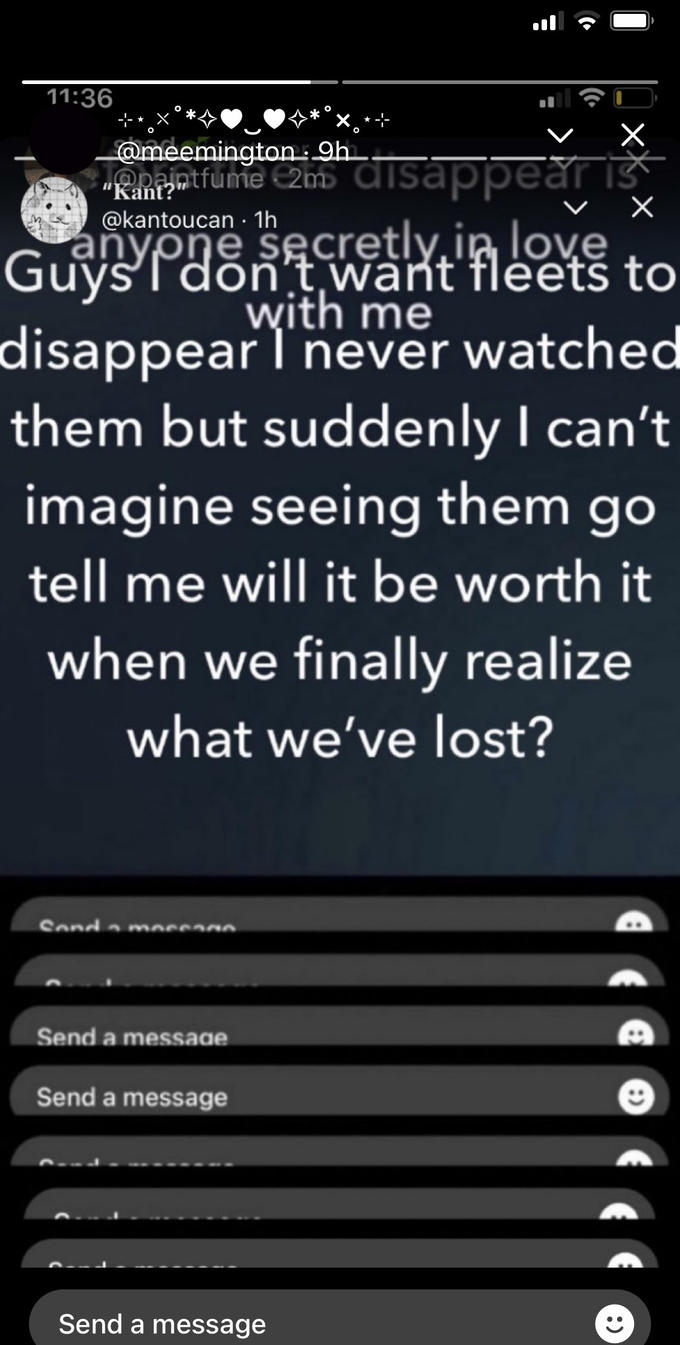

Aaaand it's gone, just like that. Did you ever even click on a Twitter Fleet? Did you ever even try to make one? And does their passing make you happy? For some reason, Twitter CEO Jack Dorsey thinks you might be happy. From their start, Fleets were controversial. Like any social media platform that hops onto the ephemeral-story bandwagon, they’re bound to be hated on and compared to the rest of the platforms that have already done so.
Pioneered by Snapchat, and then later solidified as a primary means of social-posting by Instagram, the integration of ephemeral-story content into any platform draws controversy and comparison to these forefathers. But did Fleets have the chance at transcendence over this inevitable backlash?
Well, guess not. On August 3rd, Twitter removed Fleets. In a tweet from @Twitter, posted on July 14th, the company stated, “We're sorry or you're welcome.” And of course, it’s written in all lowercase, like Twitter is some anxious, 2015 teenager trying desperately to be “different” by turning off their auto-cap.
Usually, these kinds of dumb assumptions we make about people based on their capitalization patterns are silly and loose in nature. To assume someone’s self-consciously attempting to be quirky, alluded only through when they capitalize and when they don’t, is corny and over-indulgent. We know this now in 2021 when the nuance of the “to auto-cap or not-to-auto-cap” timeline has come full circle, but here in this instance with Twitter tweeting, the comparison to a flighty, self-conscious teen might actually be grounded. Twitter’s proven in other historical backtracks that they’re often embarrassed by their decisions and resistant to change.
Remember when Vine was around? Even if you weren’t on the internet in 2013, you’ve definitely seen Vine compilations on YouTube, which almost consistently have over 2 million views each. Without a doubt, Vine was a necessary step forward for current meme culture. With its six-second limit, Viners were forced to be creative within the app’s confounds — restricted parameters are known for increasing creativity. When people are limited within a format, they have a foundation to bounce off of, which gives the brain more room for inventiveness. This philosophy of Vine is similar to another platform that limits its creators.
This being Twitter, of course, which purchased Vine early on (only four months after it was founded). In the Vine founders’ pitch to Twitter, they harked on this “short-form” idea that resonated with the Twitter higher-ups: They created their app around the same philosophy.
According to The Verge in an article published in 2016, called “Why Vine Died,” Twitter saw Vine as “a near-perfect video analog to its flagship app’s short-form text posts.” They bought the company for $30 million dollars in October 2012.
Ultimately, they were right about Vine’s possibility of success. Vine couldn’t have been a better investment for them and a better fit for their short-form philosophy of posting. For all the time that Vine was becoming relevant, it was owned by Twitter. People made careers out of Vine, like Logan Paul, who had roughly 4 billion loops across all his content.
Vine was one of those apps in 2014 and 2015 that most people had on their phones just because of the hype around it. Even if they didn’t post content or go on it much, they were seeing Vines and Viners everywhere regardless, across Instagram, YouTube, Reddit, etc. Vines would circulate these platforms with larger user bases, helping Vine harness more renown and curiosity. Similar to how TikTok is now, you either understood how to make a Vine or you didn’t, but regardless, you had the app downloaded or saw a Vine clip reposted elsewhere.
This widespread acknowledgment of Vine, as in what it was doing for memes, was fully saturated within the headspace of the social-media mainstream. That’s why, in 2016, when Twitter announced it was deleting Vine, it was a shock to everyone. Say you were this person in 2016 who hadn’t downloaded Vine yet. Being this hypothetical person, you had probably seen countless Vine compilations on YouTube to the point where you never considered Vine was struggling.
Twitter’s reasons for deleting Vine were thematically related to this “YouTube Vine compilation” enjoyment. In the social media landscape of 2016, Vine’s competitors were any other social app that let its users share videos, and a lot of the time, the videos being shared were reposted Vines. Most notably, these Vine-repost platforms were YouTube, Snapchat and Instagram, with Instagram only adding 15-second videos to its platform in June 2013, around the same time as Vine’s engagement and relevance began to skyrocket.
According to The Verge, Twitter executives saw Vine’s engagement rates consistently drop after 2014 due to competition, and Viners began moving to other places like Instagram who could provide better exposure across their app than Vine could. Instagram’s “Explore” page is an example of this. Viners could get their videos on the Explore page and gain followers directly. This painted Vine as a middle man. If most people were watching Vines reposted on Instagram and YouTube, then why not just cut the middle man out?
But couldn’t Vine have made itself into less of a middle man, establishing itself as a mainstream platform with chances for a creator’s growth? They could have just adopted an Explore page feature to further their relevance and engagement rates, and ultimately, keep their audience and creators.
Instead, Twitter executives would say, “[Vine] didn’t move fast enough to differentiate,” told to The Verge by an executive in 2016. Instead of catching up, Twitter decided to give up. A year before its death, Twitter fired Rus Yusupov, one of Vine’s co-founders and the app’s creative director for all its years under Twitter. Many saw this as the beginning of the end. On October 27th, 2016, the day Twitter announced Vine’s deletion, Yusupov tweeted to the world, “Don’t sell your company!”
In place of Vine, TikTok/Musical.y began to rise. Both TikTok and Musical.y were created in 2015, a year before Vine’s deletion, and they both acted as migration zones for ex-Viners. TikTok, in 2021, has billboards on the highway and ads playing during the Superbowl. The “For You” page of TikTok shows how a platform like Vine could have easily kept up with Instagram’s Explore. This is why the argument of Vine not differentiating itself sooner is so strange because most other apps adopt each other’s modes of posting eventually.
That’s what has happened with ephemeral-story content for instance. Instagram first borrowed the idea from Snapchat and received hate for it. Soon though, within a year or two, everyone was posting Insta Stories. Nobody looks at TikTok’s For You page and says they ripped off Instagram. TikTok would just say in response the same thing Instagram said when they integrated Reels: They have to adapt to survive.
Twitter’s deletion of Vine alludes to them not wanting to adapt. Twitter executives have consistently not stolen other platform’s modes of posting. Twitter’s history alludes to a common philosophy of a lot of internet forums that are reliant on simplicity and consistency over time.
Remember how awkward it was when Twitter made tweets 280 characters? Jack Dorsey, in his idealized future, sees Twitter as a never-changing forum, one which holds no opinions and whose format speaks for itself. When he’s pressed by outside voices to add to Twitter’s features for its betterment or the app’s longevity in general, one can feel the weird dance he does to keep Twitter from appearing as, for the lack of a better word, “cringe” for doing so.
Similar to 4chan or Reddit, Twitter values simplicity and consistency over time. This is unlike Instagram, which always seems to take every up-and-coming platform as a threat, then adapts to it, and then doesn’t care about the backlash. For something like Insta’s Stories, most people saw it initially as a Snapchat rip-off and a lot of users refused to engage with it on a moral basis. However, over time, Stories were bought into, where now, they’re essential in how we identify with Instagram.
So if Twitter has historically been hesitant to change, why change now and why with Fleets? It had to be a big step for Dorsey. Of course, they knew there’d be backlash. They took a risk, and in their minds, by the end of eight months, it hadn’t paid off.
So they backtracked. They made a big announcement and said, “We’re sorry or you’re welcome,” like anyone would say, desperately trying to seem self-aware in order to avoid appearing cringe. But ultimately, Twitter’s indecisiveness as a corporate entity is the cringiest thing of all. Were Fleets’ engagement statistics really that bad that they weren’t even worth continuing? Would they have ever transcended the backlash and comparison, like Insta Stories were able to do? We’ll never know because Twitter refuses to release the real engagement statistics of Twitter Fleets.
It’s true that public perception of Fleets on Twitter alluded to limited engagement. From what was tweeted about Fleets in their final days, most people didn’t touch them out of pride or thought they were just for thirst-trapping. This became the concluding sentiment for Fleets with most users in those final days. The ones who had never Fleeted before decided to “join the fun” and made their only Fleet ever a dick pic.
But the thing is, Fleets were used by avid Tweeters. Twitter admitted this. In their “Goodbye Fleets” blog post from July 14th, VP of Consumer Product Ilya Brown stated, “We built Fleets to address some of the anxieties that hold people back from tweeting, Fleets are mostly used by people who are already tweeting to amplify their own tweets and talk directly with others.”
Frequent Fleeters, as alluded to from this statement, tended to be people already heavily engaged with Twitter. In alt-Twitter spheres, for example, there was a practice of “re-fleeting” (essentially screenshotting and “re-fleeting” someone’s Fleet). In a way, it was a less-permanent retweet and something that existed in and for Fleet viewership only. These re-fleets strengthened circles on Twitter, helping people gain followers and community like the statement says, “To amplify their own Tweets and talk directly with others.”
But apparently, these avid tweeters are not who Twitter made Fleets for. Again, as stated above, they said in their “Goodbye Fleets” blog post, “We built Fleets to address some of the anxieties that hold people back from tweeting.” This was ultimately a miscalculation.
But honestly, when looking at Instagram Stories for comparison, does anyone only post stories and no posts because they’re anxious? Unless the Instagram page is that of an up-and-coming rapper (who’s most likely a bot), no one else on Instagram only posts stories and has zero posts: Insta Stories weren’t made for people who feel too shy to post regularly.
So why were Fleets created for anxious users if all other ephemeral-story features on all other apps, besides maybe Snapchat whose platform is exclusively ephemeral stories, were created to amplify already present voices on the platform? Through this question/contradiction, it’s hard to see why Fleets were even made and then ultimately why they were removed.
The Twitter Fleet could have accumulated nuance over time. The Twitter Fleet could have built its own cultural signifiers. But no. Jack had to backtrack because ultimately, he saw Fleets as a threat to Twitter’s purity. It’s not good to assume someone else’s thoughts, but it’s pretty obvious that Dorsey and other Twitter executives feel pressure to keep Twitter as a one-dimensional forum. If they didn’t want active tweeters to be posting Fleets, it shows that they don’t want to add more layers of chaos to the chaos.
Depending on your take on social media in general, this is either highly noble or nauseatingly self-righteous. Twitter going forward, as a platform that, compared to others, has decreasing levels of engagement and new users, needs to rethink what it wants to be.
Fleets could have been part of that new future. Twitter could have kept them despite their, most likely, embarrassing statistics that they refused to release. They could have kept their Fleeters happy, and designed AI to block and deactivate nudity and spam. But instead, this whole, less-than-a-year saga has come to an end and proves once again that Twitter can’t make its mind up on how to move forward, and more importantly if they even have to try so hard in the first place.
click here to read this article in the September 2021 Meme Insider issue.
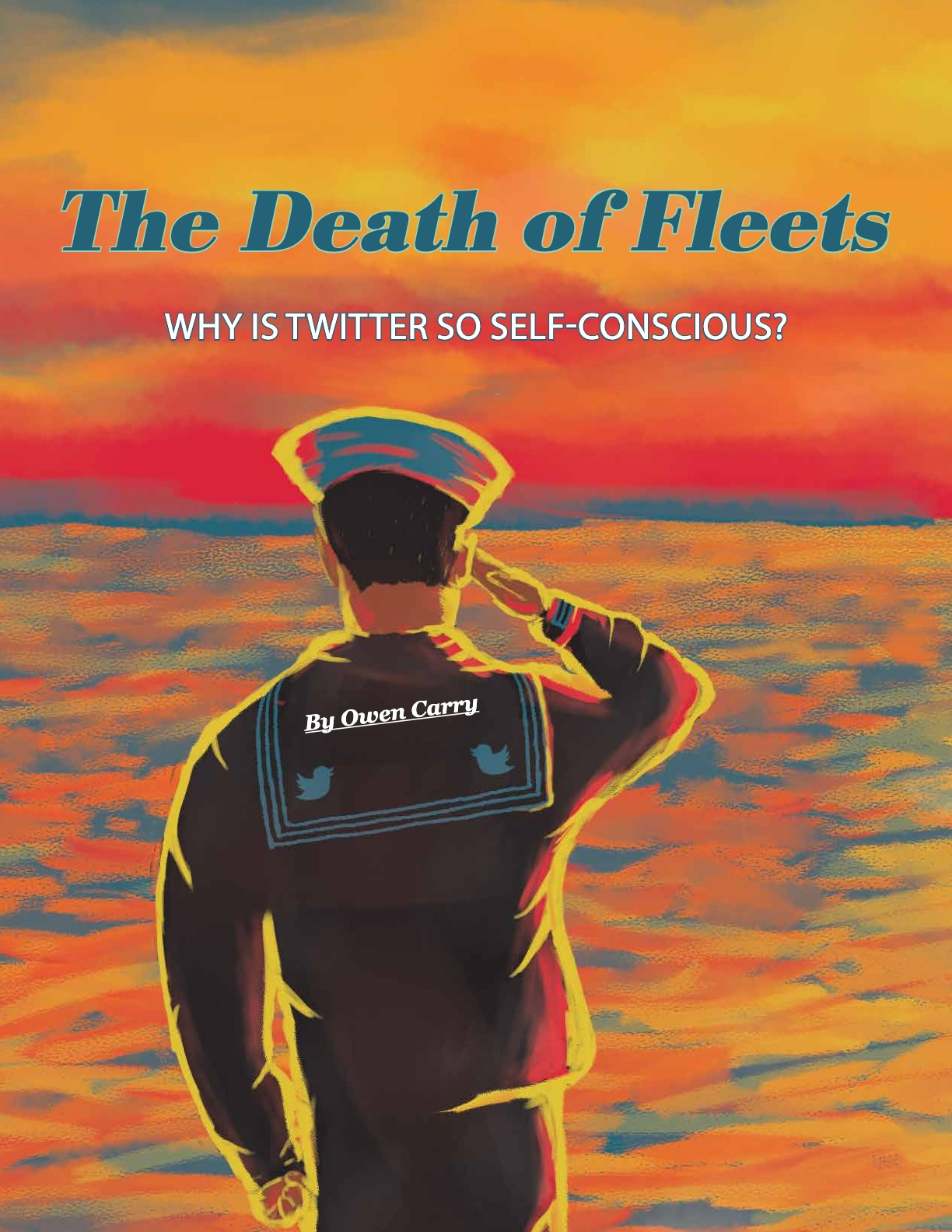

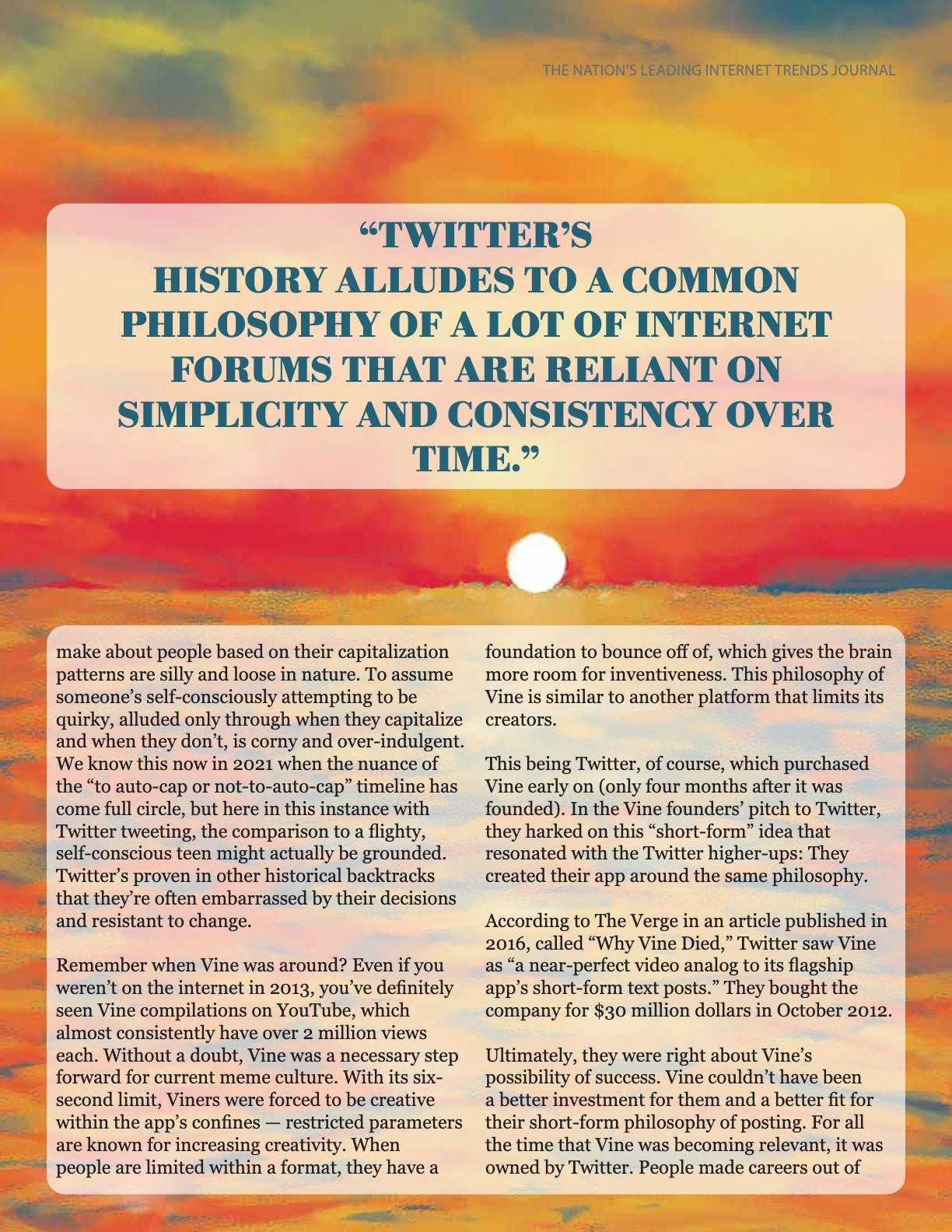
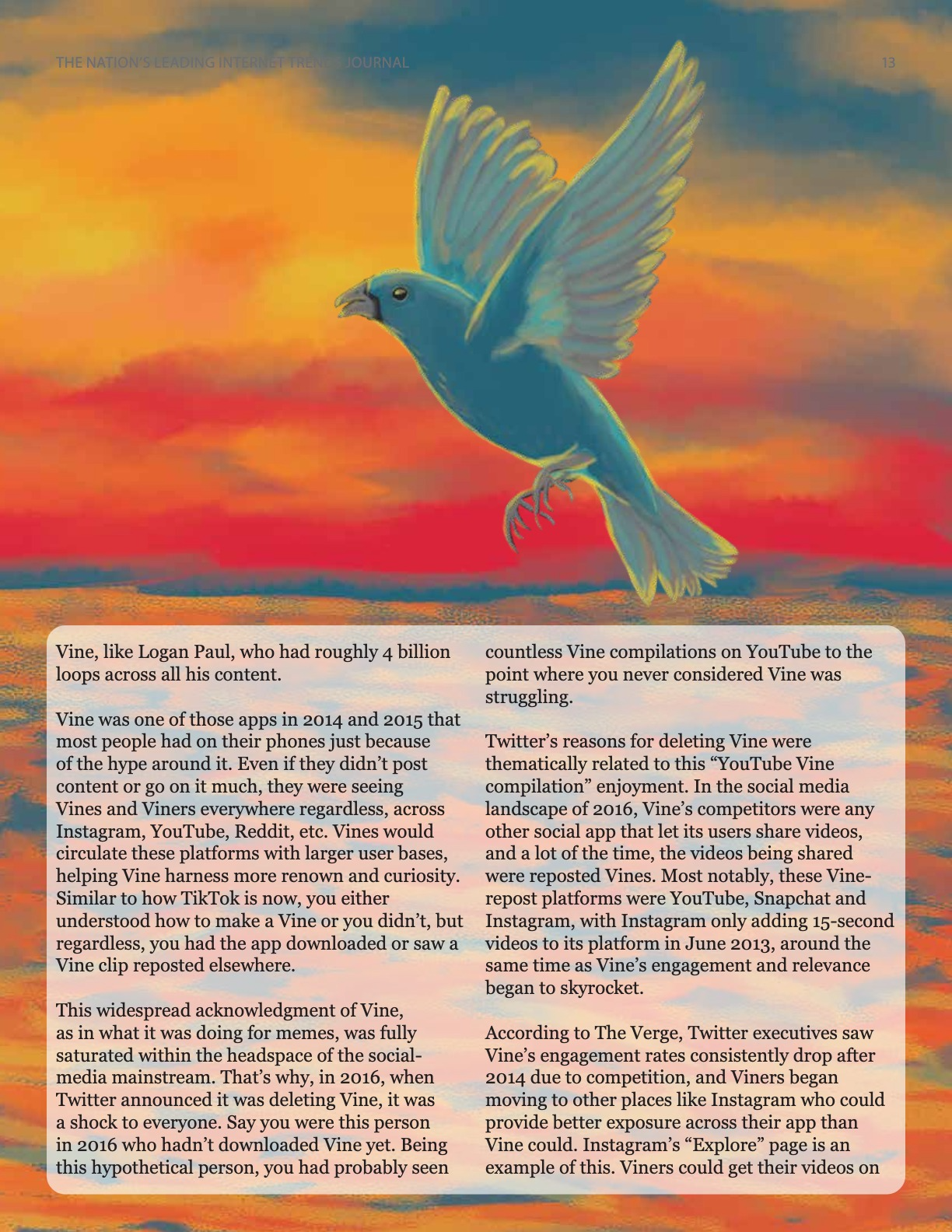

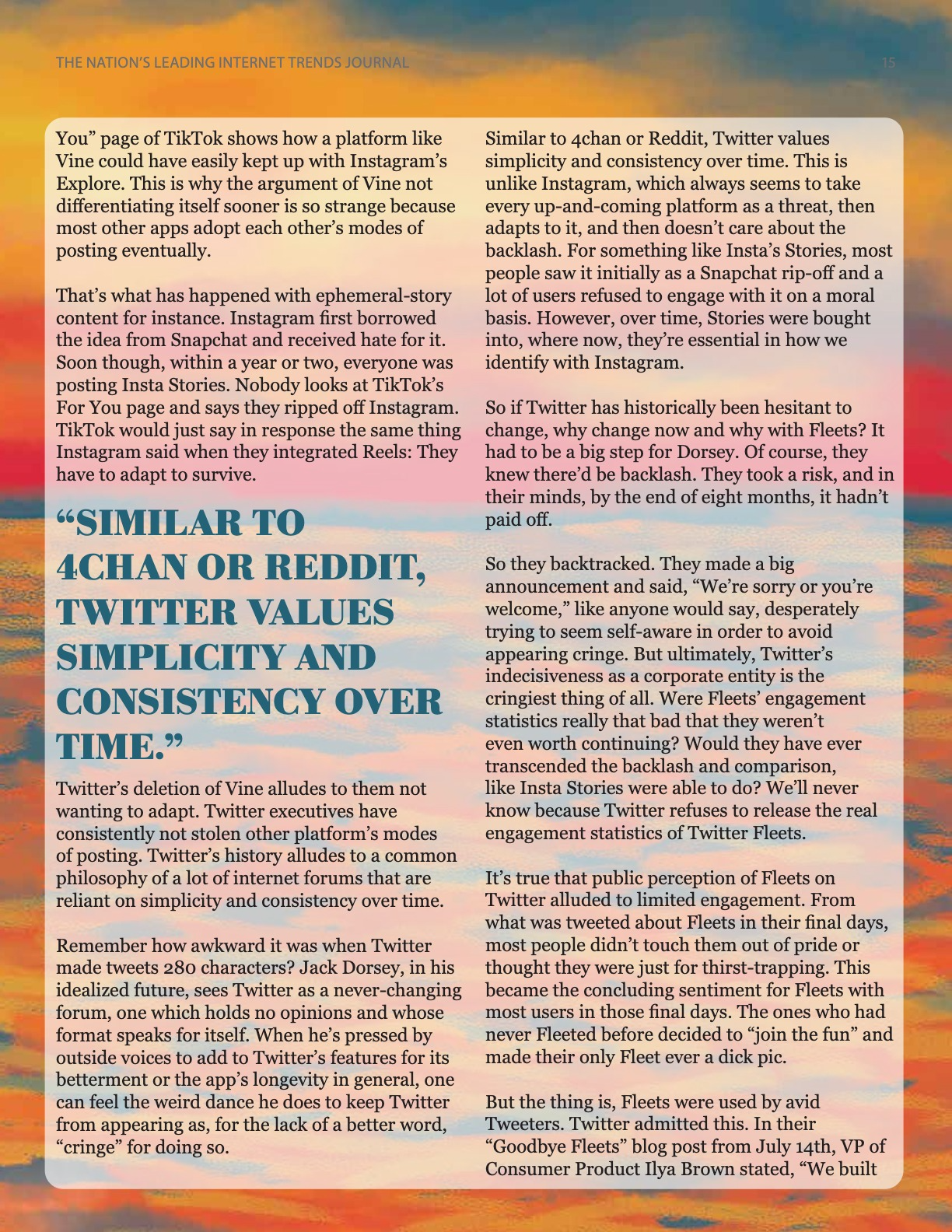

©owencarry.com